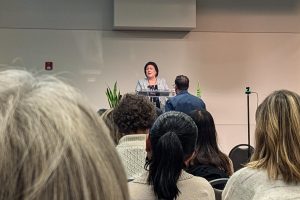Teaching in a pandemic
How professors adapted their curriculum to the online classroom
November 3, 2020

Last spring, when classes shifted to an online teaching modality, professors were faced with a daunting task. They needed to quickly adapt to an online format while simultaneously upholding the integrity of their curriculum and adjusting to the new normal.
Associate professor of the Old Testament, Bo Lim, was familiar with online teaching prior to COVID-19. Lim discussed the advantages and challenges of online teaching.
“There is more content online than I would (have) in a face-to-face class. Because inevitably in a face to face situation, we would get engaged in some kind of discussion, and we would run out of time. Inevitably every quarter, I would have to trim lecture material,” Lim said.
Lim discussed how teaching online has led to a decrease in the discussions that typically happen in class and has worked to ensure there are substantial discussions even through Zoom.
“What has decreased though is discussion. I find this absolutely valuable. What I have chosen to do is have Zoom time for discussion. In this regard, I think it’s been adequate,” Lim said. “What I don’t like about Zoom though is that there is still this sort of performative expectation.”
Assistant professor of global development, Mohammad Qadam Shah is teaching his course entirely online with a combination of synchronous and asynchronous lectures. Shah said the impact of teaching primarily online has been a mixed bag.
“The impact has been both positive and negative. In positive terms, I believe online modality is student-centered, which provides some flexibility for the students to read and listen to the lecture and course materials before they join the Zoom discussion sessions,” Shah said.
“In negative terms, some aspects of online teaching such as unequal access to technology, self-directed learning, limitations to hands-on learning, and more importantly lack of face-to-face interaction undermine the learning process,” Shah continued.
While some professors are realizing that class discussions have taken a dip in participation, there are some classes that have had strong class discussions.
Assistant professor of communication Sara Shaban started fall quarter teaching online for Public and the Media and a hybrid course for media writing, but has since then switched entirely online. Shaban explained that being in person has its benefits when trying to get to know students.
“The first time I taught in the classroom since the pandemic, it was nice to be around students and meet them, especially since this is my first year here at SPU. I like to build a rapport with my students and Zoom is a difficult way to do that,” Shaban said.
On the other hand, Shaban found that using two modalities for teaching presented obstacles during COVID-19 restrictions.
“The problem with [two modalities for one class] was that I could only have eight students in the classroom at a time. I couldn’t meet all of my students, and some of my students couldn’t come for a variety of reasons,” Shaban said.
Shaban explained that in the future she will likely continue to bring in guest speakers from around the world to talk to the class over Zoom.
While the pandemic has been an uneasy time for many, SPU professors have adapted quickly to uphold the integrity and effectiveness of their curriculum for students. The professors who described their experience have all said that while it has been a difficult transition at some level, there are still good things that have come about from these online modalities for teaching their courses.
“I think the online modality (especially, the way I have designed my courses) gives more opportunities for the students to engage in the course. I see that students spend the whole time during the Zoom sessions on interactive activities such as debates, breakout groups, and discussion in the main session,” Shah said.


























































































